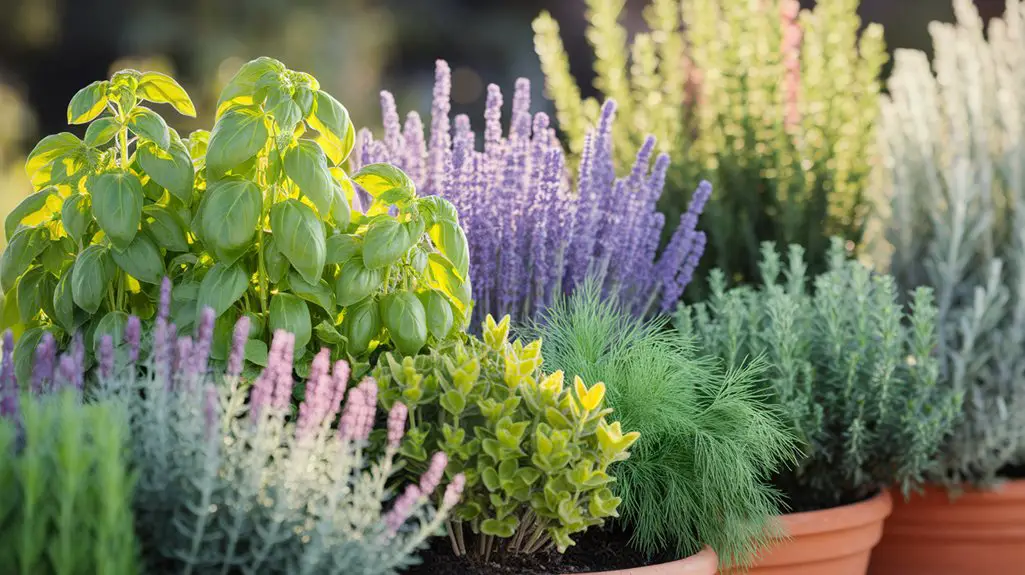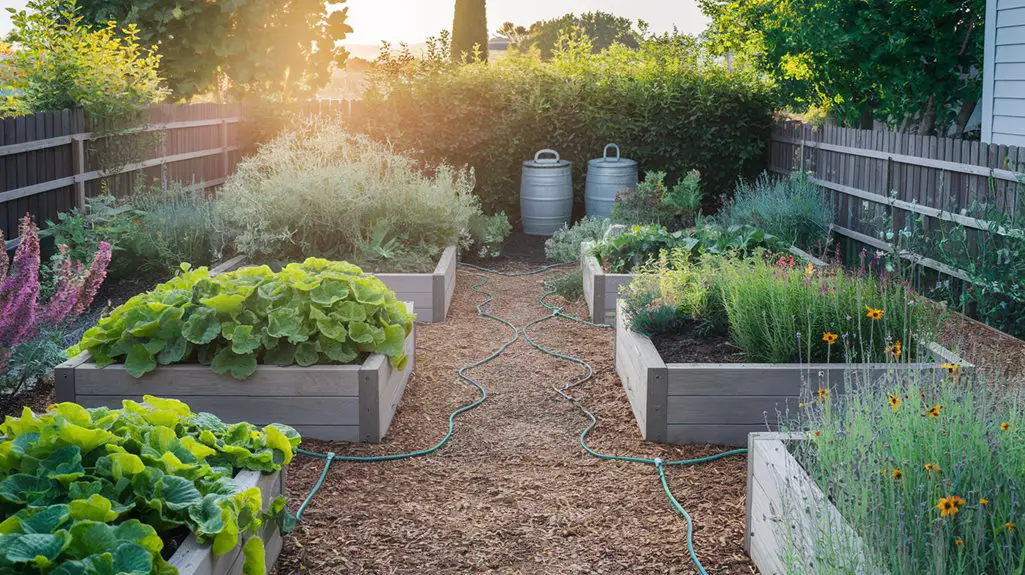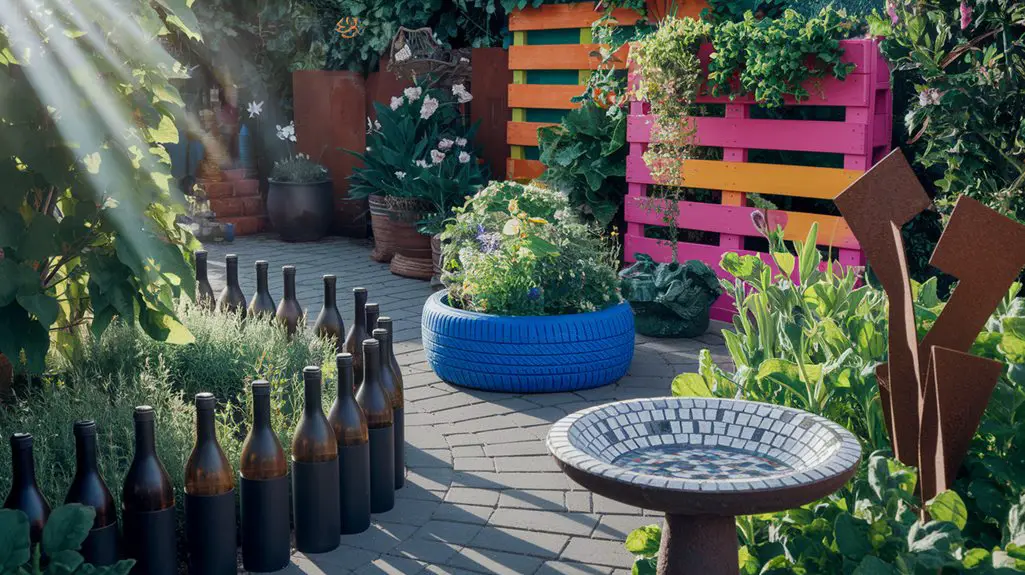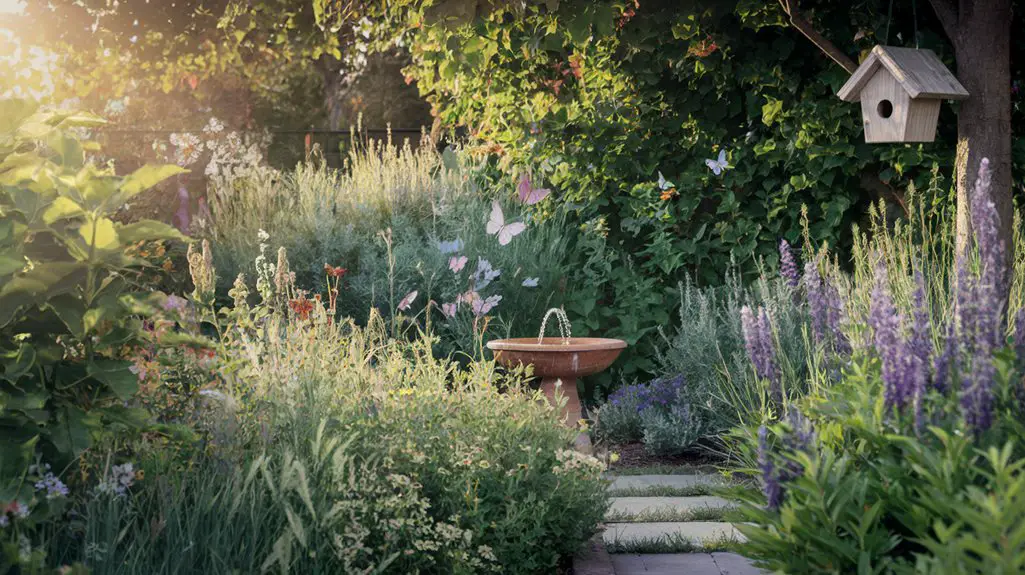Imagine, plant, and harvest—fragrant herbs transform your garden into a sensory paradise. You'll discover that aromatic herbs offer more than just culinary benefits; they provide visual interest, attract beneficial pollinators, and create memorable outdoor experiences. Whether you're working with a spacious landscape or a tiny balcony, the right combination of scented herbs can elevate your gardening experience. The secret lies in strategic placement and thoughtful combinations.
Designing Aromatic Pathways With Creeping Herbs
When planning a sensory garden experience, aromatic pathways create a delightful passage between garden areas while releasing fragrance with each step.
Select low-growing herbs that tolerate foot traffic and spread naturally between stepping stones or pavers. Creeping thyme varieties excel in this application—woolly thyme offers a soft carpet with subtle scent, while lemon thyme provides citrus notes when crushed underfoot.
Consider Roman chamomile for its apple-like fragrance and resilient growth habit, or corsican mint for an intense menthol aroma. Incorporating culinary-inspired herb garden ideas can further enhance your garden's theme and usability.
Plant these herbs 6-8 inches apart to allow proper spreading. Guarantee good drainage by incorporating sand into your soil mix, and trim back occasionally to prevent overgrowth.
You'll find these aromatic pathways not only please the senses but also naturally repel certain garden pests while attracting beneficial pollinators.
Vertical Herb Gardens for Maximizing Fragrance

Vertical herb gardens maximize both growing space and aromatic impact by positioning fragrant plants strategically at different heights.
Install wall-mounted planters near windows or doorways where passing breezes will capture and distribute essential oils. Arrange herbs according to their aromatic strength, with powerful scents like rosemary and lavender at eye level for immediate sensory engagement.
For small spaces, try pocket planters or repurposed pallets, which create microclimates where different herbs can thrive. Incorporate Mediterranean varieties like oregano, thyme, and sage in upper sections where they'll receive maximum sunlight and warmth.
Reserve lower positions for moisture-loving herbs such as mint and lemon balm. Additionally, consider incorporating year-round herb gardens that allow for a continuous supply of fresh flavors throughout the seasons.
Don't forget to include trailing varieties like creeping thyme or trailing rosemary to cascade downward, creating waterfall-like curtains of fragrance that activate with every gentle touch.
Creating Mediterranean-Inspired Scent Gardens

Mediterranean-inspired scent gardens transport your senses directly to sun-drenched hillsides of Greece, Italy, and southern France through carefully selected aromatic plantings.
This classic garden style combines drought-tolerant herbs that thrive in well-drained soil and full sun, creating an aromatic retreat in your landscape.
To create your Mediterranean scent garden:
- Incorporate signature herbs like rosemary, lavender, thyme, sage, and oregano—planted in drifts for visual impact and fragrance concentration.
- Add structural elements such as terracotta pots, gravel paths, and stone walls to enhance authenticity and improve drainage.
- Integrate silvery-leaved plants like santolina and curry plant alongside your herbs to capture the distinctive palette of Mediterranean landscapes.
Position your garden near seating areas or windows to maximize enjoyment of these transportive fragrances throughout the seasons. Additionally, consider incorporating culinary herbs to elevate your cooking and enhance the overall experience of your garden.
Companion Planting for Enhanced Herb Aromas

The strategic pairing of compatible plants can greatly amplify the aromatic qualities of your herb garden while simultaneously improving plant health and vigor.
Consider planting lavender alongside rosemary and thyme, as they share similar growing requirements and create a harmonious scent profile when their oils mingle in warm air.
Basil thrives next to tomatoes, not only improving their flavor but also enhancing its own aromatic intensity.
Plant chamomile near mint to boost essential oil production in both herbs.
Interplanting nasturtiums with oregano and marjoram helps repel pests while adding complementary floral notes to your garden's bouquet.
Incorporating raised beds into your garden design can further enhance the growing conditions for these fragrant herbs.
You'll find that these thoughtful combinations not only maximize fragrance but also optimize growing space and create natural pest management systems within your aromatic sanctuary.
Container Arrangements for Fragrant Herb Collections

When designing container arrangements for fragrant herbs, strategic grouping allows you to create portable scent stations that can be placed wherever you want to enjoy their aromatic benefits.
Consider both visual appeal and growth requirements when combining different herbs in a single planter.
- Layer herbs vertically with trailing varieties like creeping thyme along the edges, medium-height plants like lavender in the middle, and tall specimens such as rosemary as centerpieces.
- Group herbs with similar watering needs—Mediterranean herbs like sage, thyme, and oregano prefer drier conditions, while mint and lemon balm thrive with more moisture.
- Use containers with good drainage and quality potting soil mixed with 30% perlite to guarantee proper aeration for root health and ideal oil production. Additionally, incorporating beneficial insects into your garden can enhance pollination and pest control, leading to a more thriving herb ecosystem.
Seasonal Planning for Year-Round Herbal Scents
Maintaining a fragrant herb garden throughout the year requires strategic planning that accounts for seasonal growing cycles and climate variations. By selecting herbs with different peak seasons, you'll enjoy aromatic benefits regardless of the weather. Additionally, understanding seasonal herb garden planting techniques can enhance your garden's productivity.
| Season | Best Herbs | Key Maintenance |
|---|---|---|
| Spring | Chives, Mint, Lemon Balm | Prune winter damage, divide perennials |
| Summer | Basil, Lavender, Rosemary | Regular harvesting, adequate watering |
| Fall | Sage, Thyme, Oregano | Harvest for drying, protect tender varieties |
| Winter | Bay Laurel, Winter Savory, Rosemary | Move containers indoors, reduce watering |
For winter months, consider growing cold-hardy varieties like rosemary and winter savory outdoors while keeping tender herbs like lemon verbena in containers that can be brought inside during freezes.
Night-Scented Herb Gardens for Evening Enjoyment
Creating a night-scented herb garden allows you to extend the sensory enjoyment of your outdoor space well after sunset, when many herbs actually release their strongest fragrances.
Position these aromatic plants near patios, walkways, or beneath windows where evening breezes can carry their scents indoors.
- Evening primrose releases a sweet, lemony aroma after dusk and features delicate yellow blooms that open dramatically at twilight.
- Night-scented stock offers an intoxicating clove-like perfume most potent during evening hours.
- Lavender continues its calming fragrance into nighttime, making it perfect for areas where you'll relax after dark.
Incorporating creative herb garden ideas can further enhance the beauty and aromas of your outdoor space, drawing you outside even more during the evenings.
Install subtle lighting that won't overwhelm the sensory experience but provides enough illumination to navigate the garden safely while appreciating these nocturnal performers.
Culinary Herb Spirals With Layered Fragrances
Herb spirals represent one of the most efficient and visually striking ways to grow multiple culinary herbs while maximizing their aromatic potential. This three-dimensional design creates various microclimates that accommodate herbs with different growing requirements.
Begin construction with sun-loving Mediterranean herbs like rosemary, thyme, and sage at the top where drainage is excellent. Place basil, oregano, and marjoram in the middle section where moisture levels are moderate. Reserve the lower, damper areas for mint, chives, and parsley.
When planning your spiral, consider both culinary compatibility and fragrance progression. Position strongly aromatic herbs like rosemary strategically to prevent them from overwhelming delicate scents.
As you move around your spiral, you'll experience a choreographed sequence of fragrances, from the piney notes of rosemary to the sweet anise perfume of fennel. Additionally, incorporating layered fragrance techniques can enhance the overall sensory experience of your herb garden.
Conclusion
Your fragrant herb garden, like Babylon's famed hanging gardens, can transform ordinary outdoor spaces into sensory sanctuaries. Whether you've chosen aromatic pathways, vertical arrangements, Mediterranean themes, or herb spirals, you're creating a practical Eden that nourishes both body and spirit. Remember to balance your design with seasonal considerations for year-round enjoyment. With these techniques, you'll cultivate not just herbs, but an aromatic legacy worthy of ancient garden traditions.




